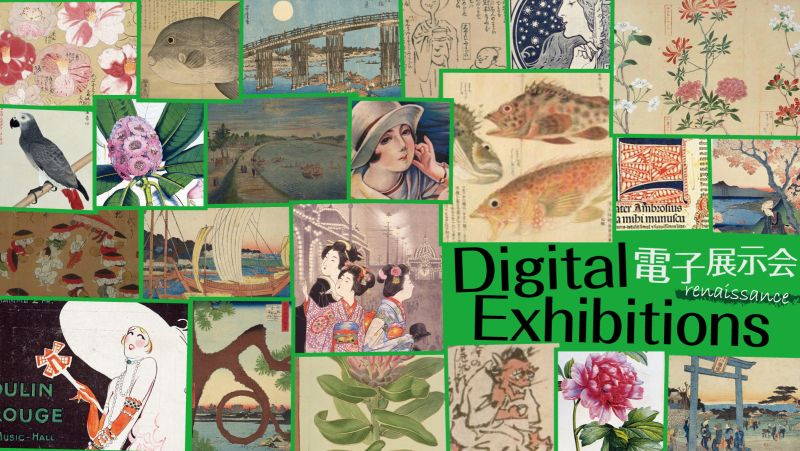Asagao (Morning Glory) Boom in Edo and Meiji Periods and Books

Morning glories were introduced from Tang and Baekje as a medicinal herb during the Nara period (710-794). They were known as kenigoshi and by the medicinal name kokuchu. Morning glories were mainly cultivated in medicinal herb gardens. In the Edo period (1603-1867), as horticultural culture developed, morning glories became popular. There was a boom in henka asagao (variant morning glories) during the Bunka and Bunsei eras (1804-1830) and again during the Kaei and Ansei eras (1848-1860). There was a time during the Meiji period when morning glories experienced a boom in popularity. This web page briefly introduces the three morning glory booms.
Asagao Boom during the Bunka and Bunsei Eras
First, let us look at the morning glory during the Bunka and Bunsei eras. The boom is said to have started with a morning glory fair held in the fall of 1816 (Bunka 13) at Asakusa Daienji Temple and Ueno Kan'eiji Temple in Asakusa. From this time onwards, several times more colors than the traditional two or three were developed, and the flower patterns and leaf shapes became more varied. In this way, the variety of these variant morning glories increased. Growers competed for the best flowers, and Tokakai, a traditional Japanese flower competition, began for variant morning glories. Reflecting this trend, gardening books featuring morning glories were published.
However, people's interest shifted to Omoto (Rohdea japonica) and Matsubaran (Psilotum nudum) during the Tempo and Koka eras (1830-48), and the boom in variant morning glories died out.
Asagao Boom during the Kaei and Ansei Eras
The second boom in variant morning glories was during the Kaei and Ansei eras (1848-60). Variant morning glories were cultivated primarily by samurai and planters. NABESHIMA Naotaka, a hatamoto (samurai retainer), and NARITAYA Tomejiro, a gardener, became famous as variant morning glory growers. NABESHIMA Naotaka was a magistrate of the Northern District in Edo and a cultured person who enjoyed cultivating rare varieties of morning glories and dianthus. NARITA Tomejiro, a gardener, was so enthusiastic about breeding and popularizing variant morning glories that he called himself the Morning Glory Master. He published an illustrated book that represents this era.
Asagao Boom of the 1880s to 1890s (Meiji 20s and 30s)
The third morning glory boom arrived in the 1880s (Meiji 20s). Morning glory enthusiast clubs, where members competed in cultivation techniques and exchanged seeds, were established in various places, including Osaka, Kyoto, and Tokyo. There were also clubs that published magazines.
Modern scientific techniques were also incorporated into the breeding of morning glories, leading to a preference for large-flowered varieties.
※Other images than the materials introduced here can also be viewed on the National Diet Library Digital Collections. After clicking the images on this webpage, please follow the link to the National Diet Library Digital Collections."Asagao Gaho" (Morning Glory Illustrated Report), "Sendai Asagao Kai Kaiho" (Sendai Morning Glory Association Bulletin), and "Tokyo Asagao Kenkyūkai Kaiho" (Tokyo Morning Glory Research Association Bulletin) can be accessed through the Digitized Contents Transmission Service for Individuals.
References
- 国立歴史民俗博物館 編, "伝統の朝顔 : くらしの植物苑特別企画" (国立歴史民俗博物館 1999)
(Kokuritsu rekishi minzoku hakubutsukan ed., Dento no asagao : Kurashi no shokubutsuen tokubetsu kikaku, Kokuritsu rekishi minzoku hakubutsukan 1999) - 国立歴史民俗博物館 編, "伝統の朝顔 : 日本の伝統植物・くらしの植物苑 2" (国立歴史民俗博物館 2000)
(Kokuritsu rekishi minzoku hakubutsukan ed., Dento no asagao : Nihon no dento shokubutsu, kurashi no shokubutsuen 2, Kokuritsu rekishi minzoku hakubutsukan 2000) - 国立歴史民俗博物館 編, "伝統の朝顔 3" (国立歴史民俗博物館 2000)
(Kokuritsu rekishi minzoku hakubutsukan ed., Dento no asagao 3, Kokuritsu rekishi minzoku hakubutsukan 2000)
